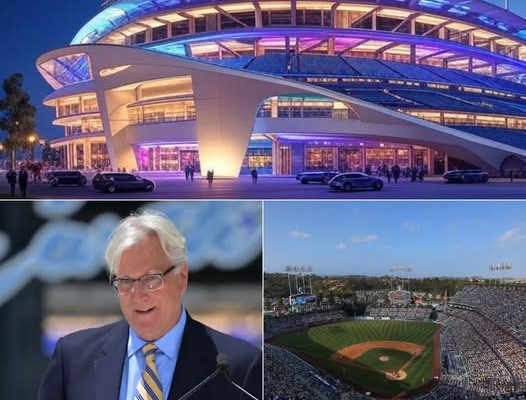BREAKING: “This is my last wish for retirement,” said Dodgers owner Mark Walter as he unveiled a bold, sweeping $2.6 billion renovation project that will transform Dodger Stadium into one of the most technologically advanced and environmentally conscious sports venues in the world. In a surprise press conference delivered from the club level balcony overlooking center field, Walter addressed a crowd of media, local officials, and longtime Dodger faithful with an emotional message: “This is my legacy. My parting gift to a fan base and city that has given me everything.” The Dodgers owner, known for his measured leadership and business savvy, laid out a dramatic vision that merges Mid-Atlantic architectural inspiration with a futuristic design language rooted in cutting-edge sustainability and immersive technology.
The announcement stunned many, not only for the scope of the stadium renovation, but also for the declaration that this would be Walter’s final major act before stepping back from the spotlight. A man not typically known for public emotionalism, Walter stood confidently with renderings projected behind him of a stadium that, by the 2028 season, would no longer just be the oldest Major League Baseball stadium west of the Mississippi—but a reimagined marvel of sports innovation. As he spoke, a crowd of reporters sat wide-eyed, scribbling furiously while the plans unfolded. What once began as whispers of a minor facelift had grown into a full-blown stadium revolution.
At the heart of the $2.6 billion project is a fundamental rethinking of what it means to attend a live sporting event. While Dodger Stadium has long held the nostalgic charm of baseball’s golden years, it is now set to be reborn into a modern coliseum. The new plans feature a full overhaul of all luxury suites with a focus on individualized design, private digital concierge access, and direct-to-seat AI-powered service. Each suite will feature customizable LED panels, AR displays that allow fans to access real-time player stats, and integrated climate control systems powered by renewable energy. The redesign promises to retain the intimacy of premium seating while embracing personalization at a scale rarely seen in sports.
Beyond the suites, fan engagement will take a quantum leap through the stadium’s ambitious embrace of augmented reality. With the tap of a phone or the donning of stadium-provided AR glasses, fans will be able to enter a layered, interactive world of data visualizations, digital storytelling, and gamified experiences. Walter explained how this would bring generations together—older fans could still soak in the game with the breeze and sun of Chavez Ravine, while younger generations could explore the science behind pitch velocity, player conditioning, and even receive spatially accurate, AR-guided stadium tours narrated by Dodgers legends. A “DodgerVerse,” as insiders are calling it, will be available through a proprietary mobile platform exclusive to ticket holders.
But what may set the project apart more than anything else is its holistic approach to sustainability. Every inch of the redesign carries a commitment to Walter’s dream of creating the world’s greenest sports venue. Powered by a massive underground geothermal system and over 30,000 square feet of solar paneling installed on stadium roofing and parking structures, Dodger Stadium will be a net-positive energy producer. Rainwater collection systems will irrigate the field and surrounding vegetation, while all food packaging within the stadium will be 100% compostable. Waterless urinals, low-flush systems, and vertical gardens will help ensure the facility reduces water usage by more than 45% compared to current benchmarks. To Walter, these features are not luxuries—they are mandates. “If we’re going to invest this much in the future,” he said, “we have to ensure there is a future.”
The renovation will also include the largest overhaul of general seating in the stadium’s history, introducing what Walter called “tech-forward seating.” These seats will feature built-in charging stations, biometric access controls, haptic feedback integration for sensory experiences tied to the game, and voice-activated ordering systems for concessions. Even bleacher seats will receive upgrades, with embedded OLED displays that provide replays, trivia, and social interactions for fans who opt into the experience. And for those concerned about the loss of the stadium’s iconic views and old-school charm, the renovation plans feature a carefully designed balance between old and new. The outfield pavilions will retain their character, though refreshed with historical storytelling touchpoints and interactive museum-style installations throughout.
In collaboration with leading Mid-Atlantic architecture firms—many of whom made their mark on Washington D.C.’s Nationals Park and Philadelphia’s Comcast Technology Center—the project will bring a blend of classical symmetry and minimalist sophistication. That influence is seen in the plans for expanded concourses designed with natural light in mind, high arching walkways that mirror the Chesapeake bridges, and museum-grade materials that marry durability with aesthetic brilliance. Walkways and open plazas will double as cultural event spaces, integrating with Los Angeles’ local art scene and inviting year-round community engagement.



